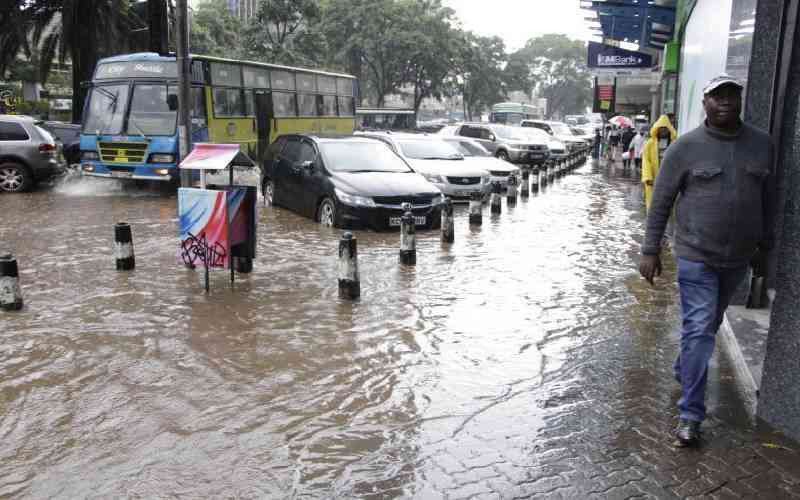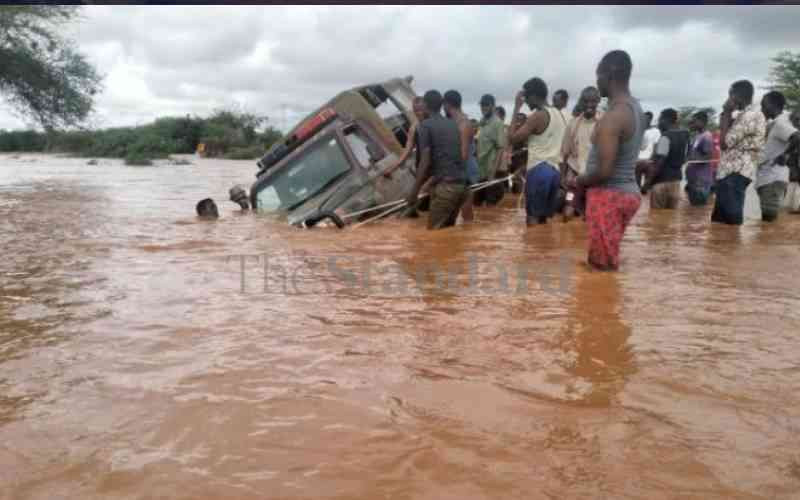The warning of impending El Nino-induced rainfall has been with us for quite a while now and the deluge that threatened to drown out several parts of the country this past weekend should have been less of a surprise than confirmation of a vastly improved and proactive Kenya Meteorological Department.
The emergency response should therefore have been co-ordinated like the legendary Swiss watch and ruthless efficiency associated with Germans, worker bees and ants. And coming in the same week that superstorm Hurricane Sandy battered the eastern United States into an estimated $450 billion worth of damage, the comparisons in disaster preparedness show a marked lack of planning.
Although the initial precipitation was nothing compared to Sandy, an electricity substation was left paralysed and consequently, several thousand homesteads must endure power outages for the next several days as engineers fix the problem.
The rainfall showed up contractors who had done a shoddy job when building roads, residential properties and other infrastructure. Much of the rainwater and accompanying debris ended up inside peoples’ houses, major highways, as well as well as smaller streets and thoroughfares became small, snaking and raging river courses pointing to a distinct lack of drainage.
In some estates in Nairobi, perimeter walls were overwhelmed, but thankfully did not result in loss of life as they came crashing down.
Roads became impassable and left thousands of motorists stranded as water levels rose from 90 to 101mm rainfall in one short night.
The US Federal Environmental Management Authority and municipal authorities started issuing warnings to residents of the US East Coast to stock up on emergency food supplies, necessaries, or even temporarily migrate from the areas expected to bear the worst of the storm.
Lightning visit
President Barack Obama started interrogating and visiting some of the areas forecast to be in the path of the storm to uplift the residents’ spirits, and he even went further to keep political campaigning to a bare minimum, knowing full well that mismanaging the Sandy response could well cost him the job he will fight to keep tomorrow.
Schools and social places were shut and emergency service crews placed on high alert. Light craft with outboard motors were scrambled and a national emergency declared. And in the aftermath of Hurricane Sandy’s “lightning visit”, the Obama administration is looking increasingly better placed to remain in office for another four years, for the mere reason that they learnt well the lessons of Hurricane Katrina that faced the last administration.
Back home, questions abound: Kenya is in the eye of a storm literally given the incidence of flooding, industrial strikes, fires and terrorism. How ready is the National Environmental Management Authority that was created under the Kenya National Disaster Management Policy of September 2009? What does the disaster awareness kit by National Environmental Management Authority (Nema) detail? Does the police service have capacity to confront these challenges?
Has central government ceded its role to such organisations as Kenya Red Cross Society, World Vision International and other non-governmental organisations? Do public hospitals have emergency and trauma centers, sufficiently equipped, staffed and supported to handle outbreaks of larger than normal proportions?
What is the level of investment in information technology, equipment and professionalism at the Kenya Meteorological Department? Have they utilised the satellite-based tracking of climate and weather patterns so that Kenyans can get ample warning before disasters camp the doorstep?
On the flipside, rather than engage in management by firefighting, how about preventing the fires from starting in the first place? How about watchdog committees and relevant police authorities and enforce strict adherence to the Building Code and leave space for access roads and build firmer buildings? Why won’t road contractors diligently deliver on the roads masterplan, complete with provision for drainage and future expansion?
Frenzied intervention
Stay informed. Subscribe to our newsletter
If every contractor and developer was true to the Environmental Impact Assessment that is made available ahead of construction, why is the scale of disaster and likelihood of life-threatening injury so great? Can Parliament and the Judiciary play their rightful roles and ensure deterrent legislation is enacted and applied to save precious lives.
And, whereas Media and civil society have a duty to highlight areas that need improvement, all citizens should speak out when they witness blatant death-traps in the making and report the same to relevant authorities. Disaster management should be more about the level of preparedness rather than the frenzied intervention once it strikes. Remember, above normal rainfall is forecast until sometime next month.
 The Standard Group Plc is a
multi-media organization with investments in media platforms spanning newspaper
print operations, television, radio broadcasting, digital and online services. The
Standard Group is recognized as a leading multi-media house in Kenya with a key
influence in matters of national and international interest.
The Standard Group Plc is a
multi-media organization with investments in media platforms spanning newspaper
print operations, television, radio broadcasting, digital and online services. The
Standard Group is recognized as a leading multi-media house in Kenya with a key
influence in matters of national and international interest.
 The Standard Group Plc is a
multi-media organization with investments in media platforms spanning newspaper
print operations, television, radio broadcasting, digital and online services. The
Standard Group is recognized as a leading multi-media house in Kenya with a key
influence in matters of national and international interest.
The Standard Group Plc is a
multi-media organization with investments in media platforms spanning newspaper
print operations, television, radio broadcasting, digital and online services. The
Standard Group is recognized as a leading multi-media house in Kenya with a key
influence in matters of national and international interest.








